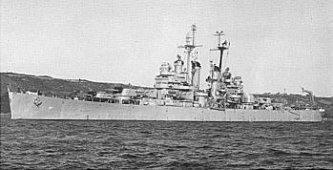

During
his tour of duty the USS Topeka was home to many a sailor.
Including
my father Paul B Bradley.

USS Topeka (CL-67) was laid down on 21 April 1943 by the Bethlehem Steel
Co. Yard located at Quincy, Mass., launched on 19 August 1944, sponsored by Mrs.
Frank J. Warren and commissioned at the Boston Navy Yard on 23 December 1944,
Capt. Thomas L. Wattles in command.

Shake Down --
1945
After shakedown cruse in the
West Indies and post-shake-down repairs, Topeka departed Boston on 10 April 1945
for duty with the Pacific Fleet. The following day, she joined Oklahoma City
(CL-91); and the two ships steamed by way of Culebra Island and Guantanamo Bay
to the Panama Canal. They transited the canal on 19 April and reported for duty
with the Pacific Fleet on the 20th. The next day, Topeka and her steaming mate
headed for Pearl Harbor, where they arrived on 2 May. Following almost three
weeks of gunnery exercises in the Hawaiian Islands, the cruiser sailed west from
Pearl Harbor as the flagship of Cruiser Division (CruDiv) 18. She entered Ulithi
Atoll in the Western Caroline's on 1 June and, after three days in the
anchorage, put to sea with Bon Homme Richard (CV-31), Oklahoma City, Moale
(DD-693), and Ringgold (DD-500) to rendezvous with Task Force (TF)
38.

Sweep of the Japanese Home Islands 1945
After
spending the latter half of June at Leyte for relaxation and replenishment, the
light cruiser returned to sea on 1 July with TF-38 for the final six-week
carrier sweep of the Japanese home islands. The task force made a fueling
rendezvous on the 8th and then began a run-in toward Tokyo that the American
planes bombed on 10 July. Next, the ships moved north to Honshu and Hokkaido for
a two-day anti shipping sweep of the area around Hokadate and Muroran. They
retired from the area for another fueling rendezvous on the 16th, but returned
to the vicinity of southern Honshu and resumed the aerial blitz of Tokyo on the
17th and 18th. On the night of the latter date, Topeka had another opportunity
to strike the enemy directly when she joined Atlanta (CL-104), Duluth (CL-87),
Oklahoma City, and the destroyers of DesRon 62 in an anti shipping sweep of the
entrance to Sagami Nada near the sea approaches to Tokyo. During that sweep, she
fired her guns at Japanese installations located on Nojima Zaki, the point of
land that marks the eastern terminus of the entrance into Sagami Nada.
Completing another replenishment retirement between 19 and 23 July, the task
force resumed its air raids on central Japan with two extensive forays against
shipping in the Inland Sea on the 24th and the 28th, respectively.
Northern Honshu Raids - 1945
A typhoon at the end
of July forced the task force to take evasive action and postpone further air
operations until the second week in August. At that time, Topeka steamed north
with TF-38 while the carriers moved into position to send sortie after sortie
against heavy concentrations of enemy aircraft on northern Honshu. Those raids —
launched on 9 and 10 August — proved eminently successful, wiping out what was
later learned to be the transportation for 2,000 shock troops being assembled
for a one-way, suicide mission to destroy the B-29 bases on Tinian. The carrier
planes paid return visits to Tokyo on the 12th and 13th and were taking off to
repeat those attacks when a message arrived on the 15th, telling of Japan's
capitulation.

Occupation Support -- 1945-46
Topeka patrolled
Japanese waters until mid-September, at which time she entered Tokyo Bay. She
remained there until 1 October when she began her homeward voyage to the United
States. The cruiser stopped briefly at Okinawa on the 4th to embark 529 veterans
and resumed her eastern progress on the 5th. On 19 October, she arrived in
Portland, OR, and disembarked her passengers. Ten days later, she steamed south
to San Pedro, Calif., for overhaul. On 3 January 1946, the warship put to sea to
return to the Far East. She reached Yokosuka, Japan, on the 24th and began duty
supporting American occupation forces in Japan, China, and in the Central
Pacific islands. During that tour of duty, which lasted until the following
fall, she called at Sasebo, Japan; Tsingtao and Shanghai in China; Manila in the
Philippines; and Guam in the Marianas. The cruiser returned to San Pedro,
Calif., on 20 November.
Decommissioned -- 1949
Following an overhaul and
operations along the west coast, she headed back to the Orient on 22 September
1947. Upon her arrival at Yokosuka, Japan, on 10 October, she became a unit of
TF-71. Operating from bases at Shanghai and Tsingtao, the warship patrolled the
north China coast while civil war raged on shore between Nationalist and
communist factions. She concluded that duty early in March and entered Nagasaki,
Japan, on the 8th. Following visits to Sasebo and Kure, Topeka sailed for the
United States on 25 April and arrived in Long Beach on 7 May. Later that month,
she moved to Pearl Harbor for a four-month overhaul at the completion of which
she returned to the west coast. Late in October, the warship resumed local
operations out of Long Beach and out of San Diego. She remained so occupied
until February 1949. On 25 February, she arrived in San Francisco to prepare for
inactivation. Topeka was decommissioned there on 18 June 1949 and berthed with
the local group of the Pacific Reserve Fleet
When I was in
the service my station was on a quad 40 mm mount. When we were in Bremerton
recently, we found 2 quad 40 mounts, less the round shields and we decided to
take some pictures on one of them. Each quad was manned by 11
people.

